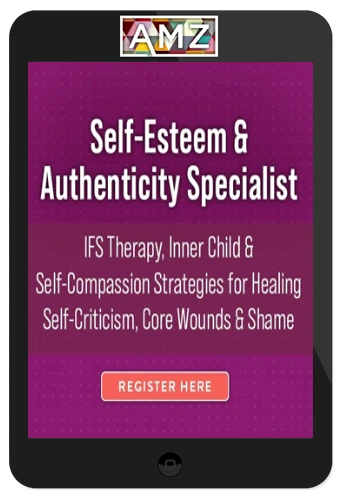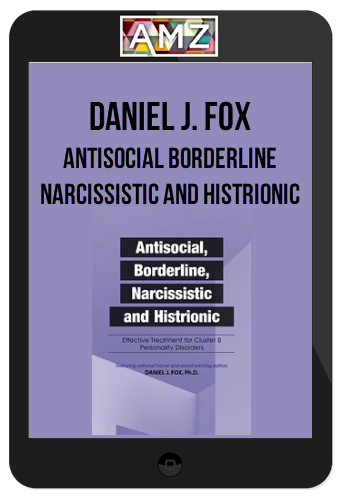Pavel Somov, Lisa Ferentz, Jay Reid and Frank Anderson – Self-Esteem and Authenticity Specialist
$99.00 $50.00
»Instant Delivery
Pavel Somov, Lisa Ferentz, Jay Reid and Frank Anderson – Self-Esteem and Authenticity Specialist
Self-Esteem and Authenticity Specialist Outline
Master the art of healing inner conflicts – no matter where they begin. Part 1 helps you to cut through self-doubt, shame, guilt, attachment wounds, and more to start building authenticity and self-esteem in clients. Take your practice further in Part 2 with Parts Work and IFS Therapy techniques to replace inner criticism with self-compassion. Part 3 gives you the tools to heal clients from families where narcissism, gaslighting, and scapegoating was present – so they can reclaim self-worth for good.
Part 1: Healing Shame, Guilt, and Self-Criticism to Build Authenticity Featuring Dr. Pavel Somov
Shame, Guilt and Motivational Apathy
- Therapy as a trigger and affect avoidance
- Clinical impasses (underutilization, stagnation, premature termination)
- Shame, guilt and a sense of not-deserving
- Secrets from self and from therapist
Tools for Catalyzing Progress in Therapy
- Normalizing, de-pathologizing, un-diagnosing
- Dialectic reframing & evolutionary psychology
- Mindfulness & metacognition
- Self-acceptance & self-compassion
- Neuroplasticity of internalization
Shame: Clinical Techniques to Move Therapy Forward
- Debunking the myth of self-sabotage
- Manage outside judgement with a self-referenced identity
- Techniques to negate sweeping generalizations
- Foster self-forgiveness with motivational innocence
Guilt: Help Clients Overcome the Debts of Guilt
- Differentiate guilt from regret
- Ordinary perfection & self-acceptance
- Master the fear of making mistakes
Self-Doubt, Dilemmas & Indecision: Interventions for Clients Paralyzed by Uncertainty
- Normalizing strategies to dissipate self-doubt
- Manage the anxiety of unpredictability with uncertainty training
- Make decisions easier with the art of arbitrary choice
- Reframe a dilemma as a choice between two rights
Strategies to Improve Motivation and Autonomy
- Find a reason-to-change with the change equation
- Techniques that leverage intrinsic motivation
- Find freedom-to-change with Choice Awareness Training (CAT)
- Pattern interruption for habit change – get clients off autopilot
Quiet Your Client’s Inner Critic
- Varieties of self-deprecation (self-criticism, self-loathing, etc.)
- Techniques to reframe symptoms as strengths
- Compassion exercises for problematic habits of self-care
- Recover from the disease model
Working through Affect Avoidance
- Exposure, mindfulness & metacognition
- Top-down & bottom-up emotional self-regulation
- Cue-conditioning of self-Regulation
Connect Specific Strategies to the Treatment of: Trauma
- Damaged goods, survivor’s guilt & avoidance of conflict
- Somatic interventions to restore the original goodness
- Strategies to survive without guilt
- Conflict avoidance: Paper tigers v. real tigers
- Exercises to rediscover self-worth
Stress and Anxiety
- Mediate the paralysis of perfection with self-acceptance
- Non-neurotic, stress-free perfectionism
- Social anxiety as shame & self-doubt: disapproval inoculation & self-referencing
- Mindfulness-based, non-anxious self-consciousness
Emotional Eating & Binge Eating
- How shame pushes clients into binge eating
- Choice Awareness Training for moderation & presence
- Self-acceptance strategies for emotional eating
- Transcend body shame by dis-identifying from the physical
Anger
- Shame of fear: Shame as a cover for anger
- The vicious guilt-anger loop
- Self-acceptance techniques for internal damage control
- Compassion exercises to let go of anger
Depression
- Depression as self-exile
- Shame as a risk factor for suicide
- Mindfulness for managing rumination
- Metacognitive silence: From negative self-talk to self accepting non-talk
Substance Abuse
- Addressing the shame of relapse
- Self-assertive trigger avoidance
- Choice awareness techniques for habit modification
- Build craving/impulse control skill power
Betrayal, Secrecy & Deception
- Separation & divorce as self-care & progress
- Secrets from therapist without rupture of rapport
- De-pathologizing the motives behind lying & deception
Research, Limitations and Potential Risks
Part 2: Parts Work to Access Inner Critics & Strengthen Self-Compassion Featuring Lisa Ferentz, LCSW-C
Exploring the concept of parts
- From Buddhism to IFS therapy
- “No bad parts”
- Understanding inner parts and resistance
- The inner critic’s protective intentions
- Basics of validating inner parts
Basics of IFS Therapy
- The core-Self and the 8 Cs
- Focusing and somatic awareness
- Accessing the wisest inner part
- Guiding dialogue between the self and inner critic
- Experiential: Externalizing the self
Starting Therapy with Protective Inner Critics
- Create an internal safe place
- Understanding your clients’ inner critic
- Breath and movement deepen inner critic soothing
- How to use art therapeutically
- Experiential writing and drawing
Accessing Inner Parts with Creativity
- Cognitive reframes for shame and criticism
- Somatic resourcing techniques, focusing, figure-eight rock, and physical embodiment
- Incorporating art into treatment
- How to use focusing and somatic awareness to access Self
- Using somatic resourcing and art to externalize Self
- Strengthening communication between parts
- Experiential: Writing exercises for shame
But… is it working?
- How to tell if parts are feeling more comfort
- Analyzing the efficacy of interventions
- Potential risks and limitations
Part 3: Tools to Release Self-Blame, Reclaim Self-Worth and Heal Attachment Wounds from Narcissistic Families Featuring Jay Reid, LPCC
Relational Dynamics of the Narcissistic Family
- The psychology of a narcissistic parent
- The scapegoat child’s function in the narcissistic family
- How the scapegoat child is made to feel the worthless
Devaluation, Deprivation and Control: The Creation of the Family Scapegoat
- Devaluation: The child is treated as if they are lower status
- Deprivation: Emotional support is withheld from the child
- Control: The child is domineered by the narcissistic parent
- How healthy developmental goals threaten relationship to parent
- 8 common pathogenic beliefs held by the scapegoat child
Use a Control-Mastery Theory (CMT) Approach to Treatment
- Goal of therapy: safely pursue sacrificed developmental goals
- How and why pathogenic beliefs persist into adulthood
- Respond in ways that do not align with the client’s pathogenic beliefs
- Overview of empirical support for CMT
- Indications and contraindications
Apply a 5-Step Case Conceptualization Method
- Step 1: Tailor treatment around each specific client’s goals
- Step 2: Identify pathogenic beliefs that block progress towards goals
- Step 3: Understand the past traumas that made those beliefs necessary
- Step 4: How the client may unconsciously test whether those beliefs are still true
- Step 5: Respond in ways that helps clients answer “No” to their tests
- Case studies: Learn to apply CMT’s 5-step case conceptualization
Strategies for Replacing Self-Blame with Self-Compassion and Self-Worth
- Specific strategies for validating the survivor’s experience
- Anxiety management tools to address survivor’s anxiety around success
- Self-compassion practices to shift clients from self-blame
- Present-focused interventions to redirect the focus from their parents to themselves
- Cognitive restructuring exercises to challenge and test pathogenic beliefs
- Use reflective questioning to explore underlying issues
- Boundary setting skills
- Go no contact and other considerations
- Research, risks and limitations
- Boundary setting skills to protect themselves from abuse
BONUS! Embracing Suicidal Parts with Internal Family Systems Therapy Featuring Dr. Frank Anderson
Learn how to approach suicidal thinking and behaviors from an IFS Therapy lens. You’ll examine pieces of the psyche that drive thoughts, feelings and actions and gain concrete strategies to help clients make peace, embrace, and find love for suicidal parts.
More courses from the same author: Pavel Somov, Lisa Ferentz, Jay Reid and Frank Anderson





